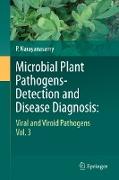Microbial Plant Pathogens-Detection and Disease Diagnosis
BücherAngebote / Angebote:
Viruses, with the primitive structural features are capable of causing diseases in all life forms on the earth. With limited morphological characteristics of the virus particles and lack of physiological functions, the need for the development of techniques based on the characteristics of the viral proteins and genomic nucleic acids was realized in order to detect, identify, differentiate and quantify viruses in the infected plants/planting materials with or without symptoms of infection. Immunoassays based on the antigenic properties of viral capsid proteins have been successfully applied for the detection of viruses in the symptomatic and asymptomatic crop and weed host plant species as well as in the vectors that are involved in the transmission of the viruses infecting crop plants. Development of monoclonal antibody technology has enhanced the sensitivity and specificity of immunoassays especially applied for the differentiation of strains of viruses with different virulence levels. Nucleic acid-based techniques have been demonstrated to have higher levels of sensitivity, specificity, reliability, reproducibility and rapidity. The viroids with only an RNA molecule have been detected by techniques based on the biological characteristics in certain cases. Application of immunoassays for viroid detection is not feasible because of the absence of a protein component that is present in the viruses. Nucleic acid-based techniques are the most reliable and sensitive tests for detection, identification and differentiation of viroids present in plants and planting materials. With the aim of providing a comprehensive knowledge of detection of viruses and viroids and diagnosis of the diseases caused by them, information distilled from extensive literature search is presented to fulfil the requirements of the researchers, teachers and graduate students of various disciplines of biological sciences. Inclusion of numerous protocols in appropriate chapters as appendix is a unique feature of this volume to enable the scientists to select the suitable methods for the various investigations.
Folgt in ca. 15 Arbeitstagen
